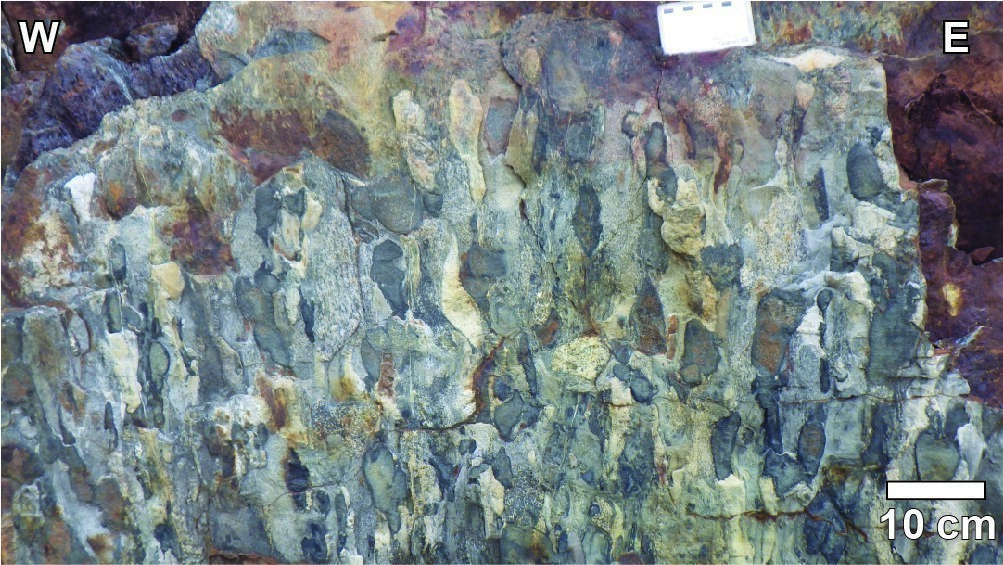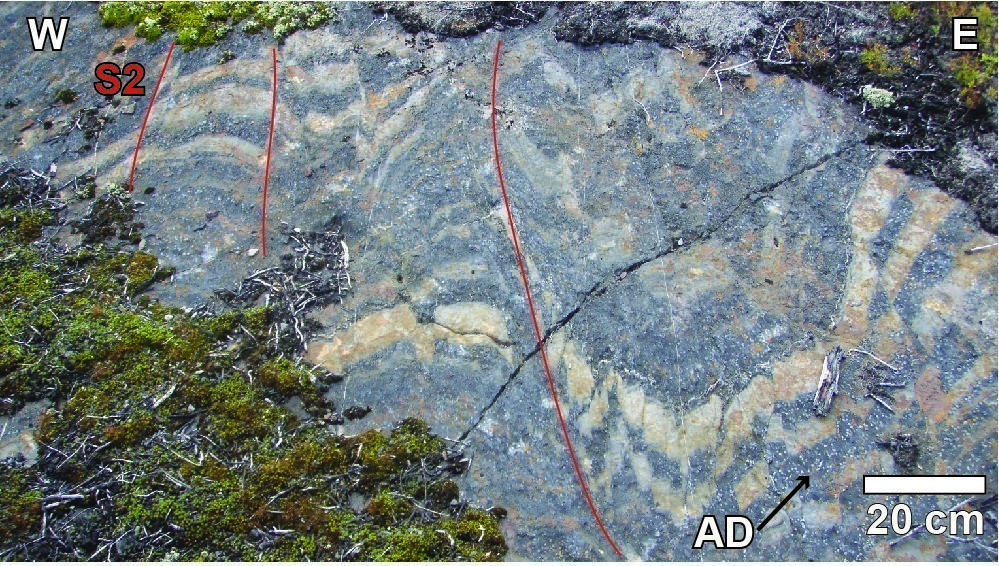
DISCLAIMER: This English version is translated from the original French. In case of any discrepancy, the French version shall prevail.
| Author: | Caty, 1977 |
| Age: | Neoarchean |
| Reference section: | None |
| Type area: | The best outcrops are located in the northern portion of sheet 32J01-200-0101. |
| Geological province: | Superior Province |
| Geological subdivision: | Abitibi Subprovince |
| Lithology: | Sedimentary rocks |
| Type: | Lithostratigraphic |
| Rank: | Formation |
| Status: | Formal |
| Use: | Active |
- Opémisca Group
- Chebistuan Formation
- Haüy Formation
- Dolomieu Member
- Pantoufle Member
- Gribouille Member
- Christian Member
- Vanina Member
- Daubrée Formation
- La Trêve Formation
- Caopatina Formation
- Messine Formation
- Stella Formation
Background
The Chebistuan Formation was established by Caty (1977) after mapping the eastern-half portion of the Richardson Township (NTS sheet 32J01), in the Waconichi Lake area. The sedimentary unit recognized on both sides of North Chebistuan and South Chebistuan lakes (unofficial names) was first interpreted as belonging to the Stella Formation (Caty, 1975). Caty (1977) continued this unit eastward and renamed it the Chebistuan Formation. Caty (1978) then attached it to the Opémisca Group. It was later considered equivalent to the Stella and Haüy Formations (Allard et al., 1979).
Description
The Opemisca Group’s Chebistuan Formation is a stratigraphic equivalent to the Stella and Haüy formations. It is composed of polymictic conglomerate, arkosic wacke and mudrock (unit nAch1). It also includes a unit dominated by polymictic conglomerate (unit nAch2) and a mudrock unit (unit nAch3).
Chebistuan Formation 1 (nAch1): Polymictic Conglomerate, Lithic Arenite and Mudrock
Unit nAch1 consists of interstratified polymictic conglomerate beds (see description of unit nAch2 below), orange-beige to greenish beige lithic arenite and medium to dark grey mudrock. These three lithologies form beds ranging in thickness from a few centimetres to more than one decimetre. This sequence, characterized by sorting, synsedimentary faults, parallel laminations and channels, appears to represent ta-td-type turbidites (Caty, 1978). In the vicinity of the Eau Noire stock (sheet 32J03-200-0202), the finer-grained and more aluminous portion of these turbidites contains andalusite porphyroblasts due to contact metamorphism associated with this intrusion.
In the Eau Noire Lake area (sheet 32J03-200-0102), two types of conglomerates were observed by Leclerc and Daoudene (2021). The first, directly located at the contact with the Eau Noire stock, consists of joint polymictic clasts of mafic to felsic volcanic rocks, gabbro and granodiorite and syenite from erosion of adjacent intrusions. Mafic volcanic rock clasts are amphibolitized and transformed into hornblende-biotite schists due to contact metamorphism. Granodiorite and syenite clasts have a slightly flattened elongated cigar form. This morphology shows constrictive-type deformation prevailing at the immediate edge of the Eau Noire stock. The second type of polymictic conglomerate, which is more widespread, consists of floating clasts in a coarse-grained, grey to dark-green lithic arenite matrix containing disseminated sulphides, giving it a typical rusty patina. Clasts consist of dark grey mudrock, volcanic rock containing millimetric plagioclase phenocrystals, and lithic arenite that can originate from the underlying stratigraphic pile (i.e. Blondeau Formation). These conglomerates are interstratified with sorted lithic arenite and mudrock beds and have oblique and cross-bedded laminations.
Chebistuan Formation 2 (nAch2): Polymictic Conglomerate, Arkosic Wacke and Arenite
Unit nAch2 is largely dominated by polymictic conglomerate associated with a few interstratified arkosic wacke or orange-beige skate arenite beds up to 10 cm thick. Polymictic conglomerate consists of felsic to intermediate intrusive rock clasts from adjacent intrusions, mafic to felsic volcanic rocks, plagioclase-pyroxene porphyritic andesite, gabbro, chert and mudrock. Clasts have an average size of <7 cm and can reach 60 cm in diameter. They are rounded and variably flattened in the regional schistosity plane. The conglomerate matrix consists of lithic arenites composed of rounded feldspar and quartz crystals, chlorite, and pyrite locally.
Chebistuan Formation 3 (nAch3): Mudrock
Unit nAch3 consists of grey to black mudrock containing local pyrite, disseminated or in laminae. The rock is characterized by slump structures and rip-up clasts (MacIntosh, 1977).
Thickness and Distribution
The Chebistuan Formation is located exclusively in the Waconichi Syncline, north of Chapais and Chibougamau (Daigneault and Allard, 1990). Its total thickness is estimated at 1050 m (Caty, 1978).
Dating
None.
Stratigraphic Relationship(s)
The sedimentary rocks of the Chebistuan Formation unconformably overlie units of the Roy Group. This discordance is evident in outcrops located in the western portion of sheet 32J01. West of Chaleur Lake (sheet 32JG14-200-0202), the contact between conglomerates of the Truce Formation and those at the base of the Chebistuan Formation is obliterated by an ENE-WSW shear zone. However, the Truce Formation and the Chebistuan Formation’s unit nAch1 are very similar. North of Opémisca Lake (sheets 32J02-200-0101 and 32J03-200-0102), the transition from Chebistuan Formation conglomerates to trachytic volcanic rocks of the Christian Member (Haüy Formation) is evidence for basaltic and andesitic potassic volcanism (MER, 1983; Hocq, 1977). In the eastern part of sheet 32J01, the sommital contact of the Chebistuan Formation is characterized by an erosional discordance over which lie Paleoproterozoic glaciogenic sedimentary rocks of the Chibougamau Formation.
Paleontology
Does not apply.
References
Publications available through SIGÉOM Examine
CATY, J L., 1975. GEOLOGIE DE LA DEMIE-OUEST DU CANTON DE RICHARDSON (COMTE D’ABITIBI-EST). MRN; DP 342, 13 pages, 2 plans.
CATY, J L., 1977. DEMIE EST DU CANTON DE RICHARDSON (COMTE D’ABITIBI-EST) – RAPPORT PRELIMINAIRE. MRN; DPV 447, 14 pages, 1 plan.
CATY, J L., 1978. CANTON DE RICHARDSON (COMTE D’ABITIBI-EST) – RAPPORT INTERIMAIRE. MRN; DP 606, 38 pages, 1 plan.
DAIGNEAULT, R., ALLARD, G O., 1990. LE COMPLEXE DU LAC DORE ET SON ENVIRONNEMENT GEOLOGIQUE – REGION DE CHIBOUGAMAU – SOUS-PROVINCE DE L’ABITIBI. IREM-MERI; MM 89-03, 290 pages.
HOCQ, M., 1977. REGION DE RAGEOT (OUEST) – LA TOUCHE (EST) (COMTE D’ABITIBI-EST) – RAPPORT FINAL. MRN; DPV 457, 79 pages, 1 plan.
LECLERC, F., DAOUDENE, Y., 2021. Géologie de la région du lac des Deux Orignaux, à l’ouest de Chapais, Sous-Province de l’Abitibi, Eeyou Istchee Baie-James, Québec, Canada. MERN; BG 2021-04, 1 plan.
M E R, 1983. STRATIGRAPHIE DES ENSEMBLES VOLCANO-SEDIMENTAIRES ARCHEENS DE L’ABITIBI: ETAT DES CONNAISSANCES. DV 83-11, 182 pages, 2 plans.
MacINTOSH, J A., 1977. GEOLOGY OF THE LANTAGNAC – LA TOUCHE AREA (COMTE D’ABITIBI-EST). MRN; DPV 497, 131 pages, 1 plan.
Suggested Citation
Ministère de l’Énergie et des Ressources naturelles (MERN). Chebistuan Formation. Quebec Stratigraphic Lexicon. https://gq.mines.gouv.qc.ca/lexique-stratigraphique/province-du-superieur/formation-de-chebistuan_en [accessed on Day Month Year].
Contributors
|
First publication |
François Leclerc, P. Geo., Ph.D. françois.leclerc@mern.gouv.qc.ca (redaction) Mehdi A. Guemache, P. Geo., Ph.D. (coordination); Claude Dion, Eng., M.Sc. (critical review); Simon Auclair, P. Geo., M.Sc. (editing); Céline Dupuis, P. Geo., Ph.D. (English version); Nathalie Bouchard (HTML editing). |



